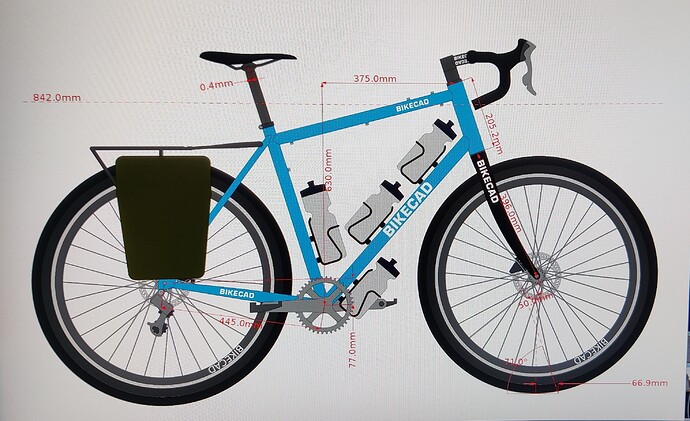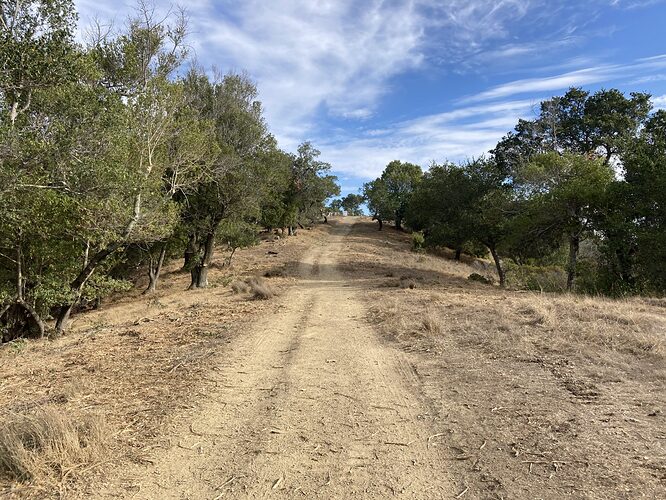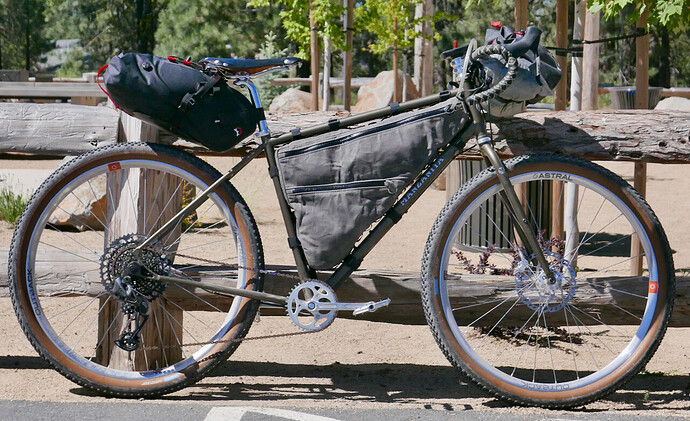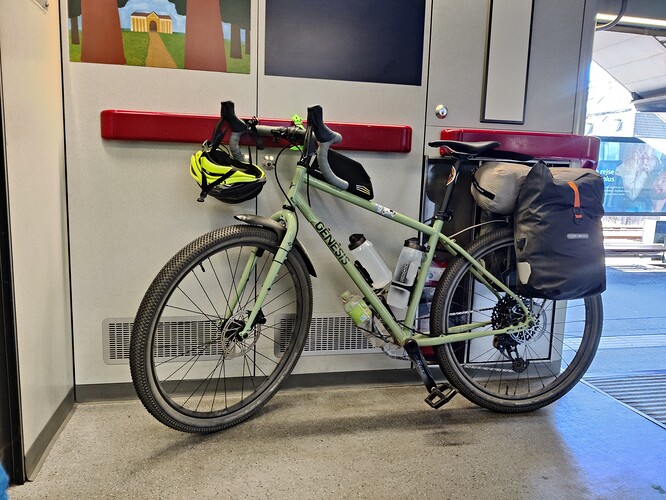I also like the simplicity of touring with a pair of panniers, but I run them on the fork instead of over the rear wheel. This gets rid of the tail wagging the dog feeling. I prefer this with low trail geo, but lots of people do it on higher trail bikes too. Front loaded touring lets you have a much lighter and more performance oriented frame.
Also stumbled upon the rodeolabs spork 3.2 huge tire clearance at 56/61 for 28"/27.5" with mud. Seems to be field proven as well which I like.
And according to their Website only starts to look silly at tire sizes <32mm. Cheaper than the enve as well.
Preliminary geometry:
HTa: 71°
STa: 73.5° < no idea what a sensible anlge is
Stack: 630
Reach: 375
CS: 445
WB: 1053
BB drop: 77
HT: 205.2
With tire diameter of 698mm: 2.2"@27.5" and 38mm@28"
Trail: 67
Rake: 50
A-C: 396
Stem: 70mm -6°
Spacer 32mm + 8mm headset topcap
Re fork choice: enve wants a 5mm on top of the stem which I don’t thinks looks that nice. Rodeo doesn’t say anything about it, but from the tech sheet their fork steerer has a ~0.15mm thicker wall
630 stack seems so huge, but in a picture it really doesn’t look like it.
Is an External cup lower headset a good idea? It would make the headtube a bit shorter and I think allows to use 1.5" as well as 1.125" Forks. Might make the job for the framebuilder a bit easier too as the bearing sits in an external cup and headtube doesn’t have to be perfect.
Firstly good one ya for getting BikeCAD. Best tool you’ll buy when looking at custom frame design and fabrication. A few thoughts:
-
STA is relevant to fit, not handling, so what’s sensible depends on where you like your saddle to be. If using BikeCAD I would always show saddle position in relation to the BB as a X and Y position. This is especially useful when you start looking at designs with bent and offset seat-tubes. 73.5 would be considered within the range of what’s normal for this kinda bike.
-
630 stack is fairly typical of a lot of the newer bikes in this class. In fact the geo you have there is almost identical to a 18" Black Mountain Cycles La Cabra. That bike has some positives reviews so you’re on the right track. That being said, unless comparing your frame to production bikes I would move away from frame dimensions such as tack/reach and start looking more at fit dimensions like the handlebar position in relation to BB and saddle. Those should be the driving dimensions of your frame.
-
I would say the same about BB drop. Look at BB height and also factor in crank length. 77mm of drop with that tyre size gives BB height of ~ 270mm. For me running 175mm cranks that would be too low. For all-road I work to min. 280mm, off-road min. 300mm and aggressive MTB min. 320mm. Maybe you plan to use shorter cranks though!
-
External Cup headsets are very typical of steel bikes and what I assume most builders would prefer to use. If you want to keep things slim EC37 is a standard discussed on this forum that may be suitable (no 1.5" forks though). Headtube will still have to be reamed/faced to a fairly high accuracy to get a good fit with the alumnium cups. Chat to your builder for sure!
-
Wolf Tooth make a 5mm top cap spacer if you don’t like the look of an extra spacer above the stem but need one for the carbon steerer. I think these are included as standard if you buy on of their headsets. Personally I think the extra spacer above the stem is a good look.
What is your height and your preferred saddle height?
External cup is the way to go. 90% of the custom bikes use the 44mm headtube (which is 48mm in diameter) for an EC44/ZS44 headset.
Thanks for the detailed reply! (Using the free bikecad version at the moment. Getting along with freecad/excel for now but I thought a rendering is much nicer to post here ![]() )
)
-
STA: OK I still have the data from my last fit and adjust STA accordingly
-
BMC La Cabra: Ha! That’s pretty much spot on! Thanks for finding it! I looked at the review and the general vibe seems to be quite positive. For comparison I read through the Tumbleweed Stargazer and Kona Sutra LTD reviews which are quite positive as well but mention going downhill singletrack capabilities which I’m not really aiming for. I also looked at the Kona Sutra (not LTD) review which makes out the bike as a boring touring bike. Comparing the Sutra 54 with the la cabra 18" here they are pretty much identical and I wonder if the favoring of the la cabra is because of the build kit alone.
-
BB height: Good idea, I plan on a 165mm crank but will take a look around. Since I don’t expect to hit large boulders I think I might get away with a lower BB for more “riding inside the bike” feeling.
-
EC it is then!
-
Hmm that topcap spacer looks quite nice. I’ll think about it.
-
My height is 172.9cm / 84.2cm inseam and 73.2cm saddleheight with a 165mm crank.
Sorry if this get’s a bit rambly at times, still in the process to nail down what I’m going for. Currently I’d like the bike in touring mode to feel at home on something like this:
With capacilities for rougher terrain but also not making tarmic feel like a punishment.
All good, I’m just a sucker for touring bikes haha. I would take the “single track capabilities” mentioned in those reviews with a grain of salt. None of the bikes listed so far would be all that capable as a true MTB, especially not with drop bars.
The favouring of the La Cabra will be a combination of build kit and tubing spec. The weights listed in the Bikepacking articles had the complete 58cm Kona Sutra at 14.5kg and the large La Cabra at 12.5kg. I know Mike Varley/BMC puts a fair bit of effort into the tubing spec with his designs but you won’t shave 2kg in tubing spec alone. Bikes that are sold as a framesets usually end up with a higher quality build than those sold as completes which is where the rest of the weight saving/performance improvements will come from. It’s also worth saying that both these bikes are of Taiwanese origin and would have to pass fairly stringent ISO 4210 testing which will usually make them stiffer (and heavier) than they truly need to be. The same testing doesn’t apply to custom made frames where what is deemed acceptable this is left up to the builder.
Oh, and back to geo discussions, another design that comes to mind is @manzanitacycles “Limousine Gravel” bike. I know Nick is active here but I can’t remember if he’s discussed the design much. Very interesting with the long rear end and short stem.
How confident are you with that reach number? How did you arrive at that number? One of the most common mistakes I see people make when designing custom frames is bumping up the stack without pulling in the reach enough.
Thanks for the callout. I’ve been meaning to write a little review of the bike on my site’s blog, but have been procrastinating.
Like many other builders on this site, I’ve experimented with different touring setups over the years. IMO there’s no right way to carry luggage.
If you want to go with most of the weight on the rear, you’ll have to increase the TT diameter to at least 31.8 and probably stick with 16mm seat stays or else the frame will be noticeably wiggly. Even going with an oversized ST would be beneficial. Longer chainstays will provide pannier/heel clearance and shift some weight back to the front wheel. The problem becomes when you want to ride this type of bike for day rides. It’ll be totally overbuilt. My old Soma Saga was like this. It just felt crummy to ride without a load.
If you want to go with most of the weight on the fork, you don’t have to over build the frame. Guys like Jan Heine will say that you’ll need to significantly reduce the trail so the weight of your luggage doesn’t overwhelm the steering. However, I toured with a friend who did this on an old Specialized AWOL and he didn’t have any trouble steering the bike. At slow speeds you’ll have to concentrate a bit more so the bike doesn’t drift off line. But once you get up to cruising speeds the bike will stabilize and be perfectly fine to ride. Wider handlebars can give you more leverage.
The thing I don’t like about packing all up front with a lowrider rack, or worse, a large porteur bag, is when you park the bike the front end becomes super floppy. It’s a pain to fish stuff out of your bags while preventing the fork from spinning. A double-sided kickstand near the BB will help out with this, but I’ve never been a fan of kickstands, especially for off-road touring.
That leaves the balanced load option. Use a frame bag to carry your heavy stuff inside the front triangle, where it’ll have the least effect on handling. Then store light items, like your bedroll and clothes behind the saddle or on the bars. You can use racks and bags or go rackless. This method usually requires a pretty minimal setup. IMO that’s a good thing. Then even when you’re riding the bike loaded, it’ll still feel sporty. This is my preferred method of packing. You can design the bike as if it were meant for day rides, but add any attachment points to carry stuff when needed.
Here’s a photo of my limousine gravel bike in bikepacking mode:
Here are some quick impressions:
- Long chainstays are nice. Without the rear wheel directly under my butt, my lower back seems a bit happier on longer rides. Pedalling efficiency seems normal. The chainstays are 22.2 tapered with no indents for chainring and tire clearance. Keeping the tube round helps with pedalling efficiency. The added weight on the front wheel improves cornering traction.
- The short stem brings back some steering responsiveness combined with the larger/heavier front wheel.
- I switched from PNW 52cm bars to some old Soma Hwy 1 44cm bars (no flare) and prefer the narrower position. 52cm is too wide for dirt road riding in my area since we get lots of wind. If I were underbiking on singletrack all the time, I’d prefer the PNW bars.
- The low BB height allows the bars to be set level with the saddle for a nice cruising position without the need for lots of spacers or a super long HT. Maybe some aero bonus points too.
@bushtrucker
Hm makes sense. So far my build kit will include the grx 815 1x and what is floating around between two bikes at the moment ![]()
I took the measurements from the Vagabond which was very comfy for my neck/shoulders and moved reach/stack around to fit the same position (± a few mm).
@manzanitacycles
I draw the line at kickstands ![]() Hadn’t really thought about the Fork spinning with the additional load, but seems like something I wouldn’t enjoy. So far, for short breakes it was quite nice to just lightly lean the bike against my legs with a pannier and being able to fish something out of them.
Hadn’t really thought about the Fork spinning with the additional load, but seems like something I wouldn’t enjoy. So far, for short breakes it was quite nice to just lightly lean the bike against my legs with a pannier and being able to fish something out of them.
My current bike (vagabond) has a 31.8mm toptube and 34.9mm downtube. Don’t have any comparison to tell if it’s overbuilt but interestingly had speed wobbles on 27.5"/57mm Tires. They were gone when switching to 29"/57mm Tires.
To make the weight discussion a bit more concrete, the luggage on the first picture is about 9.6kg including the rack. Which is my lightweight, nicer weather kit. Let’s say I want to pick up photography again and add a warmer sleeping bag, i’ll probably end up at the 12kg mark which can be the design goal for this frame. Inside main triangle, about 2.5L of water and ~700g Lock can be stored. I myself add around 68kg to the whole rig. This seems pretty modest to me for a touring rig with not that aggressive geometry. If I have to start front-loading if I want to carry more I think I’m fine with that. I could always move the water to the fork, or some food-bags for more days away from services. Maybe some hybrid of a half frame bag and the lost water capacity moved to the fork.
If this is feasible, I think that would be quite a nice fit for me!
Nice to that the combination of long CS and low trail works for you as well! ![]()
Two week tour luggage setup
To park a front loaded bike just lean it against a tree by the handlebars, not the saddle. It won’t flop over. Balanced is good too, it just requires a stout frame. I like touring on bikes 25.4 or 28.6 top tubes, which is on the flexible side of anything sensible.
73.5 STA is steep, especially if you use a zero offset seatpost. Measure your current favorite touring bikes. I find 72 to be the sweet spot, it lets you run the saddle with a zero offset post near the middle of the rails, giving you maximum adjustability. It’s silly to have STAs that just have you slide the seat all the way back.
What is often not taken into consideration rgrd STA is a rider’s leg length. What matters in terms of weight distribution[1] is not STA per se but how far behind the saddle your butt is. Longer legs = longer distance from BB to saddle (shorter cranks would increase that distance further). Because the ST is at an angle a long legged rider will sit further behind the BB than a short legged rider. A simple triangle calculation tells you exactly by how much.
All I’m saying is that comparing STA without knowing leg length contains limited information. For example a 7cm leg length deviation from the norm (average for men is around 83cm) equals a 2cm rearward shift of your butt at a 73° STA (Triangle Calculator) which is roughly equivalent to a 1.6° slacker STA, i.e. a person with an average leg length would have the butt in the same place as the person with 7cm longer legs if the former had a 71.4° STA and the latter had a 73° STA.
[1] Pedal physiology (with what knee position relative the the pedal you can produce the most power most efficiently) also plays a role but long legged people also typically have longer femurs. Such a long femur might then bring the knee into a similar position as for a short legged person who’s butt is less far behind the saddle because of the lower seat height.
STA & Saddle Position: What an absolute can of worms! Different saddles apparently come with different “Internal setback” on where the sitbones are placed and where the rails are in relation to this. Since the geometry is quite upright I’m thinking of going for a Brooks B17 and choose a STA that will be a bit slacker than what anyone else is using due to my long legs. Playing around with the Saddles from BikeCAD Database, STA of 73° seems to fit most of them with a straight seatpost. Although many of the flexy carbon seatposts seem to come with some setback which I speculate might be of their intended use with steep road bike STAs.
All else equal, if you have long legs you need a steeper STA (not slacker).
If one goes the custom bike route not doing a proper bike fit during which you can experiment which STA suits you best (which is probably quite individual) with your saddle of choice would imo be a missed opportunity.
I’d go to a bike fitter who has a “fitting bike” (Retul, Shimano for example). On such a fitting bike you can experiment with all sorts of combinations of the three relevant points in space (hands, feet or bb given a certain crank length, butt or tip of saddle or saddle center given your saddle of choice). From there you can derive the bike “fitting/sizing geometry” (as opposed to the “steering geometry”, e.g. HTA).
Be careful though, it’s a slippery rabbit hole!!
Yeah, I got a bikefit some two years ago, but it was much too aggressive for me and resulted in shoulder/neck pain starting on day 2 of riding. Though I think the rear triangle is good and I used that to set up the Vagabond and now just copy/paste to the new bike as I know that that works.
You drew conclusions from your bit fitting session on your rear triangle? What dimension on the rear triangle has an implication for “sizing geometry” (besides STA)?
Ah my personal rear triangle that is. Saddle setback and seat height ![]()
Makes sense now (if you include seatpost and saddle in the rear triangle) ![]()
The more I think about it, the bike I want to (have) build will basically be a (to me) sexier vagabond. A few tweaks of the geometry to accomodate a carbon fork, bit lower BB and internal routing for di2, brakes and rear lights. (Still have to think a bit about HTA.) Less tire clearance and the chance to go wild on the paintjob.
Currently thinking about clear coat over bare metal to have a mix of Steel/Titanium frame and rear rack. Black for most of the components, because they are black. And copper/bronze accents for bits, bobs and screws.



